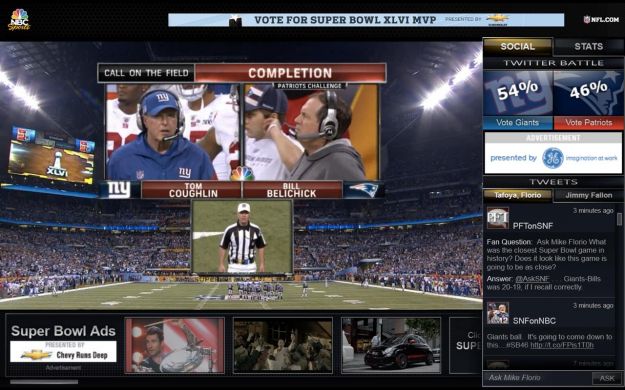
13 Feb Online television vs. interactive documentary
In the past few weeks at the Open Doc Lab, we’ve been talking classification. What are interactive documentaries? Are they films? Websites? Interactive experiences? Installation art? All of the above?
And why does it matter?
Like my colleagues at Open Doc Lab, I think these questions are critical. If we know what iDocs are—and what they do well—we can drill down on the potential audience.
Last Sunday, for the first time ever, NBC live-streamed the Superbowl. Over 2.1 million unique Internet viewers watched Eli Manning and the Giants take down my hometown favorite, the New England Patriots. While those numbers don’t compare to the record-setting 111.3 million Americans who watched the game on a television set, it’s a significant audience.
Nielsen just released a report suggesting that TV-viewing happens increasingly online. 105.1 million Americans watch Internet video daily, up 43% from last year. People under the age of 35 watch more TV online than ever before. The number of homes where TV content is watched only over the Internet jumped 22.8% since last year.
People are watching spending greater amounts of time watching video over the Internet. At first blush, that would seem to be a good thing for the interactive documentary world. But are the people who watch TV online the same people who enjoy interactive documentaries?
I’m not sure they are.
TV content is increasingly platform agnostic. People watch television programming on laptops, on tablets, on mobile devices, but we still think of it as “TV,” because the programming feels similar to what’s broadcast into America’s living rooms. It’s linear narratives with a single author. The time commitment ranges from half to a full-hour. It doesn’t require interaction, except from those of us who enjoy Hulu’s ad tailor.
In 2011, Netflix users watched more TV than movies. In fact, 60% of the content streamed over Netflix was TV. Many viewers wouldn’t just watch one episode—they’d consumer 6 or 8 at a time. Netflix made the gratification of a new episode instantaneous. On Netflix, it takes a single action—one click—to queue up the next episode. To watch another episode on DVD, users must navigate through a clunky menu or change a disc. At first blush, streaming video sites seem to offer what broadcast offers—passive consumption of linear narratives—and more of it. Any show you want, whenever you want. It’s a model based on maximum convenience.
Interactive documentaries seem to fly in the face of that kind of viewing pattern. Many of these projects demand exploration and interaction while being watched. Videos are part of many web docs, but to even play them often requires input from the user. Although we think of web docs as “documentaries,” what they ask of and offer their audience may be very different than other online videos. Perhaps games, which require interaction but sustain immersion, are a better point of comparison.
Can interactive documentaries attract audiences in the way online television does? The average web user spends less than a minute on any given site. We’re trained to watch and absorb linear content. Online, we’re trained to browse, to move. This may not be a bad thing for interactive documentaries. But it does raise questions about how these projects should use and deploy video, and how they might best connect with their audience.
Posted by Katie Edgerton/MIT




